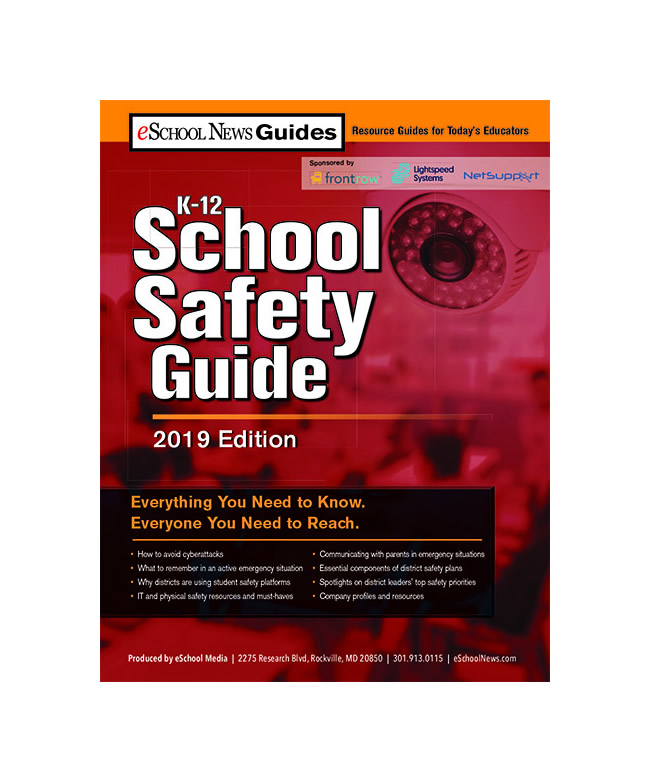On December 14, 2012, the planning of the late Dawn Lafferty Hochsprung, principal of Sandy Hook Elementary in Newton, Connecticut, saved the lives of 12 students during what CBS News called “one of the worst mass shootings in U.S. history.” Previously, she had taught students an emergency escape route out of the school. So, when the perpetrator’s semi-automatic rifle jammed, those 12 students who had been in his sights seized the opportunity and used the route to get away. That incident demonstrates the enormous benefit of a district safety plan: In a crisis, people will know what action to take rather than trying to figure out what to do in the midst of chaos.
In order to accomplish this, the district safety plan should be digitized and available on all staff computers and to all staff members—even coaches, advisers, midyear hires, and substitutes. It is essential that every staff member understands what to do during an emergency.
Related content: Safe and healthy students are a top priority
Of course, there are tasks you’ll need to undertake before reaching that point, and I’ve outlined three essential ones below: developing the plan, holding “courageous conversations,” and no- to low-cost enhancements.
Developing a district safety plan
An effective safety plan is shaped by a variety of knowledge, experience, and perspectives on the different aspects of a potential emergency. The best way to achieve this is to assemble a multidisciplinary team that meets on a monthly basis.
Related Content:
eSchool News School Safety Guide
The eSchool News School Safety Guide is here! It features strategies to help you create and maintain safe and secure learning environments, both physical and online. A new eSchool News Guide will launch each month–don’t miss a single one!
Team members should consist of these three main groups:
- Government agencies, e.g., law enforcement, the fire department, and/or the emergency medical field
- School personnel – administrators, educators, counselors, and legal counsel
- Community representatives – students, parents, and community leaders
While each district should devise a safety plan that accommodates its particular circumstances, below are eight common factors that should be considered while developing your plan.
- Delegation: School leaders need to consider to whom they can delegate tasks during and after an incident and establish how the central office and cabinet will continue to function
- The chain of command for incident response: Everyone needs to know who will be in charge until first responders arrive
- Reunification processes: This includes evacuating the building, locations for harboring students, and procedures for reuniting them with their parents
- Communication: The school leader should be the primary communicator, particularly with parents, so they need to consider the response team and technology (e.g., mobile apps, social media, backup communications systems) they’d require for crisis communications
- Press protocols
- Self-care for crisis leaders
- Debriefing: “Frontline” staff are one of the key groups from whom you will gain insights on an incident
- Managing recovery: No two recoveries will be alike
Obtain feedback and support with “courageous conversations”
Effective safety measures will need the buy-in and collaboration of different groups, particularly when it comes to many of the thornier safety issues. Therefore, school leaders need to have what I call “courageous conversations” with those groups.
For example, they may need to speak with community members about whether there will be armed or unarmed school resource officers patrolling the buildings. The National Association of School Resource Officers recommends that officers “carry all the same equipment they’d have on any other law enforcement assignment.” However, some local jurisdictions, such as Baltimore City, have opted for unarmed officers on school premises.
School leaders should also speak with schools’ mental health providers about the type of support needed in order to help the most complex students within a building. Since many complex students are capable of maintaining a facade of normalcy during person-to-person interactions, identifying them will likely be one of your most difficult tasks.
Since students tend to be much more honest about their feelings online, districts are increasingly using real-time monitoring of school-issued emails and online file storage (balanced with privacy practices). Last year, one such service, Gaggle, used machine learning and a team of safety professionals to help stop 240 student attempts to bring guns onto a school campus.
The last group with whom courageous conversations should be conducted is the school board. School board members need to understand the safety plan and support the superintendent as measures are implemented.
No-cost and low-cost safety enhancements
Not every safety measure is going to require a significant amount of funds; below are a few that can make a big difference:
- Doors that can be locked from the inside have deterred perpetrators and protected students within the rooms
- Numbered windows save time for first responders
- Individual staffer mentorship of a complex student is a no-cost, high-yield practice; school and district leaders should set the example
- Effective drills aren’t designed for convenience, but rather happen at all times of the day, involve police presence and end by debriefings and unlocking doors
I shared even more ideas about planning for school safety plans in a webinar hosted by Gaggle and the National School Boards Association in March 2019, available here.
Bear in mind: No district safety plan is ever finished. It should always be a work in progress, changing as circumstances and technology change. If you’re a member of the central office staff, you must stay in front of those factors. What will help spur your efforts is the mindset that safety is non-negotiable and should be well planned.
- 3 ways to avoid summer learning loss - April 19, 2024
- High school students say AI will change the workforce - April 18, 2024
- Motivating students using the Self-Determination Theory - April 17, 2024



